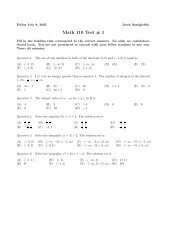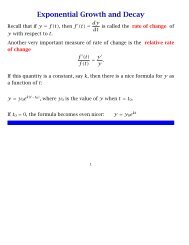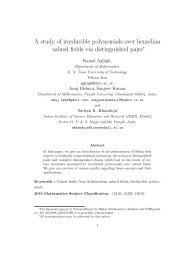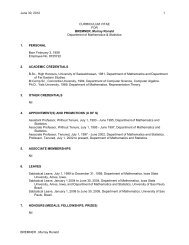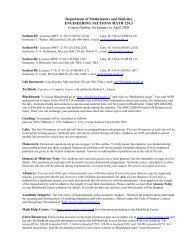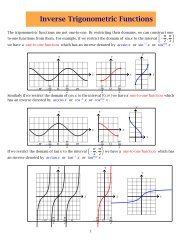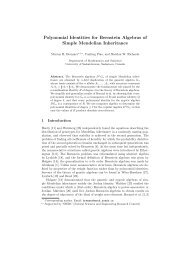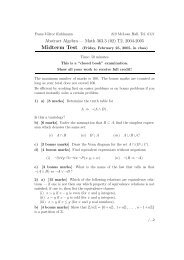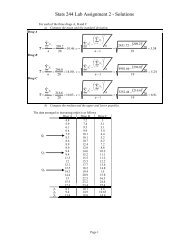pdf file - Department of Mathematics and Statistics - University of ...
pdf file - Department of Mathematics and Statistics - University of ...
pdf file - Department of Mathematics and Statistics - University of ...
You also want an ePaper? Increase the reach of your titles
YUMPU automatically turns print PDFs into web optimized ePapers that Google loves.
A COMMON GENERALIZATION OF METRIC,<br />
ULTRAMETRIC AND TOPOLOGICAL FIXED POINT<br />
THEOREMS<br />
— ALTERNATIVE VERSION —<br />
KATARZYNA KUHLMANN AND FRANZ-VIKTOR KUHLMANN<br />
Abstract. We present a general fixed point theorem which can be seen<br />
as the quintessence <strong>of</strong> the principles <strong>of</strong> pro<strong>of</strong> for Banach’s Fixed Point<br />
Theorem, ultrametric <strong>and</strong> certain topological fixed point theorems. It<br />
works in a minimal setting, not involving any metrics. We demonstrate<br />
its applications to the metric, ultrametric <strong>and</strong> topological cases, <strong>and</strong> to<br />
ordered abelian groups <strong>and</strong> fields.<br />
1. Introduction<br />
What is the common denominator <strong>of</strong> Banach’s Fixed Point Theorem <strong>and</strong><br />
its ultrametric <strong>and</strong> topological analogues as developed in [8, 9, 10, 6] <strong>and</strong><br />
in [13]? Is there a general principle <strong>of</strong> pro<strong>of</strong> that works for all <strong>of</strong> these<br />
worlds, the (ordinary) metric, ultrametric <strong>and</strong> topological, <strong>and</strong> beyond? In<br />
this paper, we give an answer to these questions. We draw our inspiration<br />
from the notions <strong>of</strong> “ball” <strong>and</strong> “spherical completeness” that are used in<br />
the ultrametric world.<br />
S. Priess’ paper [8] in which she first proved a fixed point theorem for<br />
ultrametric spaces initiated an interesting development that led to a better<br />
underst<strong>and</strong>ing <strong>of</strong> important theorems in valuation theory <strong>and</strong> to new results<br />
(see, e.g., [KU4]). This was achieved by extracting the underlying principle<br />
<strong>of</strong> the pro<strong>of</strong> <strong>of</strong> Hensel’s Lemma through abstracting from the algebraic<br />
operations <strong>and</strong> only considering the ultrametric induced by the valuation.<br />
In this paper we push this development one step further by extracting the<br />
underlying principle <strong>of</strong> various fixed point theorems. In this way, a general<br />
Date: March 22, 2013.<br />
2000 <strong>Mathematics</strong> Subject Classification. Primary 54A05; Secondary 12J15, 12J25,<br />
13A18, 54C10.<br />
The authors wish to thank the referee for his extremely careful reading <strong>and</strong> several<br />
very helpful <strong>and</strong> essential corrections <strong>and</strong> suggestions. They also thank Ed Tymchatyn,<br />
Murray Marshall <strong>and</strong> John Martin for inspiring discussions.<br />
The research <strong>of</strong> the first author was partially supported by a sabbatical grant from the<br />
Silesian <strong>University</strong> at Katowice, Pol<strong>and</strong>. The research <strong>of</strong> the second author was partially<br />
supported by a Canadian NSERC grant.<br />
1
2 KATARZYNA KUHLMANN AND FRANZ-VIKTOR KUHLMANN<br />
framework is set up that helps underst<strong>and</strong> these theorems in a more conceptual<br />
manner <strong>and</strong> to transfer ideas from one world to the other by analogies<br />
(as we will demonstrate, for instance, for the topological fixed point theorem<br />
we consider).<br />
The general framework also helps to make the use <strong>of</strong> fixed point theorems<br />
available to situations that are difficult or even impossible to subsume under<br />
the above mentioned settings. While investigating spaces <strong>of</strong> real places, we<br />
found that in certain algebraic entities, it may be much easier <strong>and</strong> more<br />
natural to define “balls” than to define the “distance” between two elements.<br />
For example, if we are dealing with quotient topologies, like in the case <strong>of</strong><br />
spaces <strong>of</strong> real places where the topology is induced by the Harrison topology<br />
<strong>of</strong> spaces <strong>of</strong> orderings, balls come up naturally as images <strong>of</strong> certain open or<br />
closed sets in the inducing topology. Therefore, we will work with ball spaces<br />
(X, B), that is, sets X with a nonempty set B <strong>of</strong> distinguished nonempty<br />
subsets <strong>of</strong> X, which we call balls. We require no further structure on these<br />
spaces. We do not even need a topology generated in some way by the<br />
balls. But let us mention that the way we formulate our theorems, the balls<br />
should be considered closed, rather than open, in such a topology, because<br />
singletons appear <strong>and</strong> are important. One can reformulate everything in an<br />
“open ball” approach, but this makes the exposition less elegant.<br />
We found the idea <strong>of</strong> centering the attention on balls, rather than metrics,<br />
in the paper [3]. But there, ball spaces carry much more structure <strong>and</strong> the<br />
conditions for a fixed point theorem are unnecessarily restrictive.<br />
We will now state our most general fixed point theorem for ball spaces.<br />
We need two notions. A nest <strong>of</strong> balls in (X, B) is a nonempty collection <strong>of</strong><br />
balls in B that is totally ordered by inclusion. If f : X → X is a function,<br />
then a subset B ⊆ X will be called f-contracting if it is either a singleton<br />
containing a fixed point or satisfies f(B) ⊂ ̸= B.<br />
Theorem 1. Take a function f on a ball space (X, B) which satisfies the<br />
following conditions:<br />
(C1) there is at least one f-contracting ball,<br />
(C2) for every f-contracting ball B ∈ B, the image f(B) contains an<br />
f-contracting ball,<br />
(C3) the intersection <strong>of</strong> every nest <strong>of</strong> f-contracting balls contains an fcontracting<br />
ball.<br />
Then f admits a fixed point.<br />
We can obtain uniqueness <strong>of</strong> the fixed point by strengthening the hypothesis:<br />
Theorem 2. Take a function f on a ball space (X, B) which satisfies the<br />
following conditions:<br />
(CU1) X is an f-contracting ball,
FIXED POINT THEOREMS 3<br />
(CU2) for every f-contracting ball B ∈ B, the image f(B) is again an<br />
f-contracting ball,<br />
(CU3) the intersection <strong>of</strong> every nest <strong>of</strong> f-contracting balls is again an<br />
f-contracting ball.<br />
Then f has a unique fixed point.<br />
These theorems will be proved in Section 2.<br />
In [13] the authors show that every “J-contraction” on a connected compact<br />
Hausdorff space X has a unique fixed point. Using the inspiration from<br />
our general framework, we obtain the following strong generalization; note<br />
that we do not require the space X to be Hausdorff.<br />
Theorem 3. Take a compact space X <strong>and</strong> a closed function f : X → X.<br />
If every nonempty closed set B in X with f(B) ⊆ B contains a closed fcontracting<br />
subset, then f has a fixed point in X. If every nonempty closed<br />
set B in X with f(B) ⊆ B is f-contracting, then f has a unique fixed point<br />
in X.<br />
This theorem <strong>and</strong> the theorem <strong>of</strong> [13] are corollaries to Theorems 1 <strong>and</strong> 2.<br />
We will show this in Section 4, where we will also present another version<br />
<strong>of</strong> Theorem 3 that is directly related to Theorem 4 below.<br />
For most applications <strong>of</strong> these theorems, it is an advantage to have a<br />
h<strong>and</strong>y criterion for the existence <strong>of</strong> the f-contracting balls. From classical<br />
fixed point theorems we know the assumption that the function f be<br />
strictly contracting. But we have learnt from the ultrametric case that if<br />
one does not insist on uniqueness, one can relax the conditions: a function<br />
does not need to be strictly contracting on the whole space, but only on<br />
the orbits <strong>of</strong> its elements (<strong>and</strong> simply contracting otherwise). While this<br />
relaxation makes the formulation <strong>of</strong> the conditions a bit longer, it should<br />
be noted that it is important for many applications in which the function<br />
under consideration fails for natural reasons to be strictly contracting on<br />
the whole space. The following way to present a fixed point theorem may<br />
seem unusual, but it turns out to be very close to several applications as it<br />
encodes (a weaker form <strong>of</strong>) the property “strictly contracting on orbits”.<br />
Consider a function f : X → X. We will write fx for f(x) <strong>and</strong> f i x for<br />
the image <strong>of</strong> x under the i-th iteration <strong>of</strong> f, that is, f 0 x = x, f 1 x = f(x)<br />
<strong>and</strong> f i+1 x = f(f i x). The function f will be called strongly contracting on<br />
orbits if there is a function<br />
X ∋ x ↦→ Bx ∈ B<br />
such that for all x ∈ X, the following conditions hold:<br />
(SC1) x ∈ Bx ,<br />
(SC2) Bfx ⊆ Bx , <strong>and</strong> if x ̸= fx, then B f i x ⊂ ̸= Bx for some i ≥ 1.<br />
Note that (SC1) <strong>and</strong> (SC2) imply that f i x ∈ Bx for all i ≥ 0.
4 KATARZYNA KUHLMANN AND FRANZ-VIKTOR KUHLMANN<br />
We will say that a nest <strong>of</strong> balls N is an f-nest if N = {Bx | x ∈ S} for<br />
some set S ⊆ X that is closed under f. Now we can state our third main<br />
theorem:<br />
Theorem 4. Take a function f on a ball space which is strongly contracting<br />
on orbits. If for every f-nest N in this ball space there is some z ∈ ∩ N<br />
such that Bz ⊆ ∩ N , then f has a fixed point.<br />
Theorem 4 does not deal with the question <strong>of</strong> uniqueness <strong>of</strong> fixed points;<br />
this question is answered in the particular applications by additional arguments<br />
that are <strong>of</strong>ten very easy.<br />
The condition about the intersection <strong>of</strong> an f-nest is not needed for Banach’s<br />
Fixed Point Theorem <strong>and</strong> may therefore appear alien to readers who<br />
are not familiar with the ultrametric case. But there, as in the case <strong>of</strong> nonarchimedean<br />
ordered groups <strong>and</strong> fields, one has to deal with jumps that one<br />
could intuitively think <strong>of</strong> as being a “non-archimedean” or “non-st<strong>and</strong>ard”<br />
phenomenon. The obstruction is that the intersection <strong>of</strong> an infinite nest<br />
<strong>of</strong> balls we have constructed may contain more than one element, at which<br />
point we have to iterate the construction. The mentioned condition makes<br />
this work.<br />
The condition on the intersection <strong>of</strong> f-nests implies that in particular,<br />
they are not empty. This reminds <strong>of</strong> a similar property <strong>of</strong> ultrametric spaces,<br />
<strong>and</strong> we take over the corresponding notion. The ball space (X, B) will be<br />
called spherically complete if every nonempty nest <strong>of</strong> nonempty balls has a<br />
nonempty intersection.<br />
To illustrate the flexibility <strong>of</strong> the concepts we have introduced <strong>and</strong> the<br />
above explained idea <strong>of</strong> making fixed point theorems available to totally<br />
new settings, we state the following easy but useful result:<br />
Proposition 5. Take two ball spaces (X1, B1) <strong>and</strong> (X2, B2) <strong>and</strong> a function<br />
f : X1 → X2 . Suppose that the preimage <strong>of</strong> every ball in B2 is a ball in<br />
B1 . If N is a nest <strong>of</strong> balls in (X2, B2), then the preimages <strong>of</strong> the balls in N<br />
form a nest <strong>of</strong> balls in (X1, B1). If (X1, B1) is spherically complete, then so<br />
is (X2, B2).<br />
In several applications, <strong>and</strong> in particular in the ultrametric setting, the<br />
function under consideration has in a natural way stronger properties than<br />
we have used so far. What we have asked for one element in the intersection<br />
<strong>of</strong> an f-nest is <strong>of</strong>ten satisfied by every element in the intersection. Therefore,<br />
it seems convenient to introduce a notion which reflects this property <strong>and</strong><br />
in this way to separate it from the condition that the intersections is nonempty.<br />
The function f will be called self-contractive if in addition to (SC1)<br />
<strong>and</strong> (SC2), it satisfies:<br />
(SC3) if N is an f-nest <strong>and</strong> if z ∈ ∩ N , then Bz ⊆ ∩ N .
FIXED POINT THEOREMS 5<br />
Self-contractive functions will appear in the hypothesis <strong>of</strong> Theorem 7, in<br />
Theorem 11, in Theorem 12, <strong>and</strong> in the pro<strong>of</strong> <strong>of</strong> Banch’s Fixed Point Theorem.<br />
The following fixed point theorem is an easy corollary to Theorem 4:<br />
Theorem 6. Every self-contractive function on a spherically complete ball<br />
space has a fixed point.<br />
For the pro<strong>of</strong> <strong>of</strong> Theorems 1, 2 <strong>and</strong> 4, see Section 2. In Section 3, we state<br />
two general attractor theorems. Section 4 is devoted to topological fixed<br />
point theorems. In Section 5, we show how to derive ultrametric fixed point<br />
theorems, <strong>and</strong> in Section 6, we discuss ultrametric attractor theorems. In<br />
Section 7 we then discuss valued fields that are complete by stages, a notion<br />
introduced by P. Ribenboim in [11]. We use Theorem 4 for a quick pro<strong>of</strong> <strong>of</strong><br />
a fixed point theorem that works in such fields (Theorem 16). This theorem<br />
can be used to show that such fields are henselian. Its application to the<br />
pro<strong>of</strong> <strong>of</strong> Hensel’s Lemma provides an example for a case where one does not<br />
have in any natural way a function that is strictly contracting on all <strong>of</strong> the<br />
space. Note also that the particularly weak form that we have chosen for<br />
(SC2) comes in very h<strong>and</strong>y for the formulation <strong>of</strong> Theorem 16.<br />
In Section 8 we discuss how to derive Banach’s Fixed Point Theorem.<br />
Our aim is not to provide a new pro<strong>of</strong> <strong>of</strong> this theorem; in contrast to our<br />
other applications, the existing pro<strong>of</strong>s in this case are much shorter. Our<br />
aim here is to show how to convert the problem from metric to ball space<br />
<strong>and</strong> to pave the way for one <strong>of</strong> our fixed point theorems (Theorem 21) for<br />
ordered abelian groups <strong>and</strong> fields. Associated with them are two natural<br />
ball spaces:<br />
• the order ball space, where the balls are closed bounded intervals, <strong>and</strong><br />
• the ultrametric ball space, where the balls are the ultrametric balls derived<br />
from the natural valuation.<br />
We discuss these ball spaces <strong>and</strong> the corresponding fixed point theorems in<br />
Section 9. The flexibility <strong>of</strong> our notion <strong>of</strong> ball space is demonstrated in the<br />
concept <strong>of</strong> hybrid ball spaces, in which we use order balls <strong>and</strong> ultrametric<br />
balls simultaneously. One <strong>of</strong> such hybrid ball spaces is used for a simple<br />
characterization <strong>of</strong> those ordered fields which are power series fields with<br />
residue field R (Theorem 27).<br />
2. Pro<strong>of</strong> <strong>of</strong> the fixed point theorems for ball spaces<br />
Pro<strong>of</strong> <strong>of</strong> Theorem 1:<br />
The set <strong>of</strong> all nests consisting <strong>of</strong> f-contracting balls is partially ordered by<br />
inclusion. There is at least one such nest since by condition (C1), there is<br />
at least one f-contracting ball. Further, the union over an ascending chain<br />
<strong>of</strong> nests consisting <strong>of</strong> f-contracting balls is again such a nest (observe that<br />
the cardinality <strong>of</strong> this union is bounded by the cardinality <strong>of</strong> the power set<br />
<strong>of</strong> X, so the union is a set). Hence by Zorn’s Lemma, there is a maximal
6 KATARZYNA KUHLMANN AND FRANZ-VIKTOR KUHLMANN<br />
nest N consisting <strong>of</strong> f-contracting balls. By condition (C3), ∩ N contains<br />
an f-contracting ball B. Suppose this ball is not a singleton. But then by<br />
condition (C2), f(B) contains an f-contracting ball B ′ . Since B ′ ⊆ f(B) ⊂ ̸=<br />
B, N ∪ {B ′ } is then a nest that properly contains N , which contradicts<br />
the maximality. We find that B must be a singleton consisting <strong>of</strong> a fixed<br />
point. <br />
Pro<strong>of</strong> <strong>of</strong> Theorem 2:<br />
Using conditions (CU1), (CU2), (CU3) <strong>and</strong> transfinite induction, we build<br />
a nest N consisting <strong>of</strong> f-contracting balls as follows. We set N0 := {X}.<br />
Having constructed Nν for some ordinal ν with smallest f-contracting ball<br />
Bν ∈ Nν , we set Bν+1 := f(Bν) <strong>and</strong> Nν+1 := Nν ∪ {Bν+1}. If λ is a limit<br />
ordinal <strong>and</strong> we have constructed Nν for all ν < λ, we observe that the union<br />
over all Nν is a nest N ′ λ . We set Bλ := ∩ N ′ λ <strong>and</strong> Nλ := N ′ λ<br />
∪ {Bλ}.<br />
If Bν is not a singleton, then Bν+1 ⊂ ̸= Bν . Hence there must be an ordinal<br />
ν <strong>of</strong> cardinality at most that <strong>of</strong> X such that Bν+1 = Bν . But this only<br />
happens if Bν is a singleton consisting <strong>of</strong> a fixed point x. If x ̸= y ∈ X,<br />
then y /∈ Bν which means that there is some µ < ν such that y ∈ Bµ,<br />
but y /∈ Bµ+1 = f(Bµ). This shows that y cannot be a fixed point <strong>of</strong> f.<br />
Therefore, x is the unique fixed point <strong>of</strong> f. <br />
Theorem 4 can be derived from Theorem 1. But as it takes essentially the<br />
same effort, we will give a pro<strong>of</strong> along the lines <strong>of</strong> the pro<strong>of</strong> <strong>of</strong> Theorem 1.<br />
Pro<strong>of</strong> <strong>of</strong> Theorem 4:<br />
Take a function f on the ball space (X, B) which is contractive on orbits.<br />
For every x ∈ X, the set {B f i x | i ≥ 0} is an f-nest. The set <strong>of</strong> all fnests<br />
is partially ordered by inclusion. The union over an ascending chain<br />
<strong>of</strong> f-nests is again an f-nest. Hence by Zorn’s Lemma, there is a maximal<br />
f-nest N . By the assumption <strong>of</strong> Theorem 4, there is some z ∈ ∩ N such<br />
that Bz ⊆ ∩ N . We wish to show that z is a fixed point <strong>of</strong> f. If we would<br />
have that z ̸= fz, then by (SC2), B f i z ⊂ ̸= Bz ⊆ ∩ N for some i ≥ 1, <strong>and</strong><br />
the f-nest N ∪ {B f k z | k ∈ N} would properly contain N . But this would<br />
contradict the maximality <strong>of</strong> N . Hence, z is a fixed point <strong>of</strong> f. <br />
3. General attractor theorems<br />
Let us derive from Theorem 6 an attractor theorem which is modeled<br />
after the ultrametric attractor theorem in [5]. We consider two ball spaces<br />
(X, B) <strong>and</strong> (X ′ , B ′ ) <strong>and</strong> a function φ : X → X ′ . Take an element z ′ ∈ X ′ .<br />
If there is a function f : X → X which is strongly contracting on orbits,<br />
<strong>and</strong> a function<br />
X ∋ x ↦→ B ′ x ∈ B ′<br />
such that for all x ∈ X, the following conditions hold:<br />
(AT1) z ′ ∈ B ′ x <strong>and</strong> φ(Bx) ⊆ B ′ x,<br />
(AT2) if φ(x) ̸= z ′ , then B ′<br />
f i x ⊂ ̸= B ′ x for some i ∈ N,
FIXED POINT THEOREMS 7<br />
then z ′ will be called a weak f-attractor for φ. If in addition f is selfcontractive,<br />
then z ′ will be called an attractor for φ.<br />
Theorem 7. (Attractor Theorem 1)<br />
Take a function φ : X → X ′ <strong>and</strong> an attractor z ′ ∈ X ′ for φ. If (X, B) is<br />
spherically complete, then z ′ ∈ φ(X).<br />
Indeed, by Theorem 6, f has a fixed point z. But by condition (AT2),<br />
fz = z implies that φ(z) = z ′ . The following version <strong>of</strong> the Attractor<br />
Theorem follows in a similar way from Theorem 4:<br />
Theorem 8. (Attractor Theorem 2)<br />
Take a function φ : X → X ′ <strong>and</strong> a weak f-attractor z ′ ∈ X ′ for φ. If for<br />
every f-nest N in (X, B) there is some z ∈ ∩ N such that Bz ⊆ ∩ N , then<br />
z ′ ∈ φ(X).<br />
4. Fixed point theorems for topological spaces<br />
In this section, we consider compact topological spaces X with functions<br />
f : X → X. We note:<br />
Lemma 9. Every compact space X together with any family <strong>of</strong> nonempty<br />
closed subsets is a spherically complete ball space.<br />
Pro<strong>of</strong>: [1, Proposition 2, p. 57] states that every “centered system” <strong>of</strong><br />
nonempty closed subsets <strong>of</strong> a compact space X has a nonempty intersection.<br />
Here, a “centered system” means a family <strong>of</strong> subsets that is linearly ordered<br />
under inclusion. This is exactly what we call a “nest”. Therefore, the cited<br />
proposition proves our lemma. <br />
In view <strong>of</strong> this lemma, we will take B to be the set <strong>of</strong> all nonempty closed<br />
subsets <strong>of</strong> X. We show how to deduce Theorem 3 from Theorem 1.<br />
Pro<strong>of</strong> <strong>of</strong> Theorem 3: Take a compact space X <strong>and</strong> a closed function<br />
f : X → X. Assume first that every closed set B in X with f(B) ⊆ B<br />
contains a closed f-contracting subset. Since X is closed, this implies that<br />
condition (C1) is satisfied. If B is an f-contracting closed set in X, then<br />
f(B) is closed since f is a closed function. Also, we have that f(B) ⊆ B,<br />
which yields that f(f(B)) ⊆ f(B). Hence by assumption, f(B) contains<br />
an f-contracting closed set, so condition (C2) is satisfied. The intersection<br />
∩ N <strong>of</strong> a nest N = {Bi | i ∈ I} <strong>of</strong> f-contracting closed sets Bi is closed;<br />
since f(Bi) ⊆ Bi for all i ∈ I, we also have that f( ∩ N ) ⊆ ∩ N . Hence by<br />
assumption, ∩ N contains an f-contracting closed set. So condition (C3)<br />
is satisfied, <strong>and</strong> Theorem 1 shows that f has a fixed point.<br />
Now assume that every closed set B in X with f(B) ⊆ B is f-contracting.<br />
Then X is f-contracting, <strong>and</strong> for every f-contracting closed set B also<br />
f(B) is closed with f(f(B)) ⊆ f(B) <strong>and</strong> hence f-contracting. Further,<br />
the intersection ∩ N <strong>of</strong> a nest <strong>of</strong> f-contracting closed sets is closed with
8 KATARZYNA KUHLMANN AND FRANZ-VIKTOR KUHLMANN<br />
f( ∩ N ) ⊆ ∩ N <strong>and</strong> hence f-contracting. Therefore, Theorem 2 shows that<br />
f has a unique fixed point. <br />
We will now show how to deduce a fixed point theorem <strong>of</strong> [13] from<br />
Theorem 3. For this theorem, we assume that X is compact, Hausdorff <strong>and</strong><br />
connected. An open cover U <strong>of</strong> X is said to be J-contractive for f if for<br />
every U ∈ U there is U ′ ∈ U such that f(cl U) ⊆ U ′ , where cl U denotes<br />
the closure <strong>of</strong> U. The function f : X → X is called J-contraction if every<br />
open cover U has a finite J-contractive open refinement V for f. For every<br />
non-connected compact Hausdorff space X there is a J-contraction <strong>of</strong> X<br />
which has no fixed points (cf. [13, Proposition 3, p. 553]); therefore, the<br />
approach using J-contractions only works for connected compact Hausdorff<br />
spaces. We cite two important facts about a J-contraction f on a connected<br />
compact Hausdorff space X:<br />
(J1) If B is a closed subset <strong>of</strong> X with f(B) ⊆ B, then the restriction <strong>of</strong><br />
f to B is also a J-contraction ([13, Proposition 1, p. 552]);<br />
(J2) If f is onto, then |X| = 1 ([13, Proposition 4, p. 554]).<br />
The following is Theorem 4 <strong>of</strong> [13]:<br />
Theorem 10. Take a connected compact Hausdorff space X <strong>and</strong> a continuous<br />
J-contraction f : X → X. Then f has a unique fixed point.<br />
Pro<strong>of</strong>: We claim that by (J1) <strong>and</strong> (J2), every closed subset B <strong>of</strong> X with<br />
f(B) ⊆ B is f-contracting. Indeed, since by (J1), f|B is a J-contraction<br />
on B, (J2) shows that either f|B is not onto, or B is a singleton {x} <strong>and</strong><br />
since fx ∈ f(B) ⊆ B, we have that fx = x. Now Theorem 10 follows from<br />
Theorem 3. <br />
The next theorem shows how to apply Theorem 4 to topological spaces.<br />
Theorem 11. Take a compact space X <strong>and</strong> a closed function f : X → X.<br />
Assume that for every x ∈ X with fx ̸= x there is a closed subset B <strong>of</strong><br />
X such that x ∈ B <strong>and</strong> x /∈ f(B) ⊆ B. Then f has a fixed point in B.<br />
Moreover, f is self-contractive, <strong>and</strong> for every x ∈ X with fx ̸= x there is a<br />
smallest closed subset B <strong>of</strong> X such that x ∈ B <strong>and</strong> x /∈ f(B) ⊆ B.<br />
Pro<strong>of</strong>: For every x ∈ X we consider the following family <strong>of</strong> balls:<br />
Bx := {B | B closed subset <strong>of</strong> X, x ∈ B <strong>and</strong> f(B) ⊆ B}.<br />
Note that Bx is nonempty because it contains X. We define<br />
Bx := ∩ Bx .<br />
We see that x ∈ Bx <strong>and</strong> that f(Bx) ⊆ Bx. Further, Bx is closed, being the<br />
intersection <strong>of</strong> closed sets. This shows that Bx is the smallest member <strong>of</strong><br />
Bx .<br />
For every B ∈ Bx we have that fx ∈ B <strong>and</strong> therefore, B ∈ Bfx . Hence<br />
we find that Bfx ⊆ Bx.
FIXED POINT THEOREMS 9<br />
Assume that fx ̸= x. Then by hypothesis, there is a closed set B in X<br />
such that x ∈ B <strong>and</strong> x /∈ f(B) ⊆ B. Since f is a closed function, f(B) is<br />
closed. Moreover, f(f(B)) ⊆ f(B) <strong>and</strong> fx ∈ f(B), so f(B) ∈ Bfx. Since<br />
x /∈ f(B), we conclude that x /∈ Bfx, whence Bfx ⊂ ̸= Bx . We have now<br />
proved that f is strongly contracting on orbits. Further, B ∈ Bx , whence<br />
Bx ⊂ B, f(Bx) ⊂ f(B) <strong>and</strong> therefore, x /∈ f(Bx). This shows that Bx is<br />
the smallest <strong>of</strong> all closed sets B in X for which x ∈ B <strong>and</strong> x /∈ f(B) ⊆ B.<br />
Take an f-nest N . Lemma 9 shows that ∩ N is nonempty. Take any<br />
z ∈ ∩ N . Choose an arbitrary Bx ∈ N . Then z ∈ Bx <strong>and</strong> thus, Bx ∈ Bz .<br />
So we have that Bz ⊆ Bx . Therefore, Bz ⊆ ∩ N . We have proved that f<br />
is self-contractive.<br />
Theorem 11 now follows from Theorem 4. <br />
5. Ultrametric fixed point theorems<br />
Let (X, d) be an ultrametric space. That is, d is a function from X × X<br />
to a partially ordered set Γ with smallest element 0, satisfying that for all<br />
x, y, z ∈ X <strong>and</strong> all γ ∈ Γ,<br />
(U1) d(x, y) = 0 if <strong>and</strong> only if x = y,<br />
(U2) if d(x, y) ≤ γ <strong>and</strong> d(y, z) ≤ γ, then d(x, z) ≤ γ,<br />
(U3) d(x, y) = d(y, x) (symmetry).<br />
(U2) is the ultrametric triangle law; if Γ is totally ordered, it can be replaced<br />
by<br />
(UT) d(x, z) ≤ max{d(x, y), d(y, z)}.<br />
We obtain the ultrametric ball space (X, Bu) from (X, d) by taking Bu to<br />
be the set <strong>of</strong> all<br />
B(x, y) := {z ∈ X | d(x, z) ≤ d(x, y)} .<br />
It follows from the ultrametric triangle law that B(x, y) = B(y, x) <strong>and</strong><br />
that<br />
(1) B(t, z) ⊆ B(x, y) if <strong>and</strong> only if t ∈ B(x, y) <strong>and</strong> d(t, z) ≤ d(x, y) .<br />
In particular,<br />
B(t, z) ⊆ B(x, y) if t, z ∈ B(x, y) .<br />
Two elements γ <strong>and</strong> δ <strong>of</strong> Γ are comparable if γ ≤ δ or γ ≥ δ. Hence if<br />
d(x, y) <strong>and</strong> d(y, z) are comparable, then B(x, y) ⊆ B(y, z) or B(y, z) ⊆<br />
B(x, y). If d(y, z) < d(x, y), then in addition, x /∈ B(y, z) <strong>and</strong> thus,<br />
B(y, z) ⊂ ̸= B(x, y). We note:<br />
(2) d(y, z) < d(x, y) =⇒ B(y, z) ⊂ ̸= B(x, y) .<br />
If Γ is totally ordered <strong>and</strong> B1 <strong>and</strong> B2 are any two balls with nonempty<br />
intersection, then B1 ⊆ B2 or B2 ⊆ B1 .
10 KATARZYNA KUHLMANN AND FRANZ-VIKTOR KUHLMANN<br />
The ultrametric space (X, d) is called spherically complete if the corresponding<br />
ball space is spherically complete. The following theorem (with<br />
i = 1 in (3)) appeared in [10]:<br />
Theorem 12. (Strong Ultrametric Fixed Point Theorem)<br />
Take a spherically complete ultrametric space (X, d) <strong>and</strong> a function f : X →<br />
X. Assume that f satisfies, for all x, z ∈ X:<br />
(3)<br />
(4)<br />
Then f has a fixed point.<br />
x ̸= fx =⇒ ∃i ≥ 1 : d(f i x, f i+1 x) < d(x, fx) ,<br />
d(z, fx) ≤ d(fx, f 2 x) =⇒ d(z, fz) ≤ d(x, fx) .<br />
Pro<strong>of</strong>: Our theorem follows from Theorem 6 once we have shown that<br />
f is self-contractive on the ball space (X, Bu). We define<br />
(5) Bx := B(x, fx)<br />
<strong>and</strong> observe that x ∈ Bx . Taking z = fx in (4), we find that d(fx, f 2 x) ≤<br />
d(x, fx). Hence by (1), Bfx = B(fx, f 2 x) ⊆ B(x, fx) = Bx. By induction<br />
on i it follows that f i x ∈ Bx . By (3), d(f i x, f i+1 x) < d(x, fx) for some<br />
i ≥ 1. Then by (2), we have that B f i x = B(f i x, f i+1 x) ⊂ ̸= B(x, fx) = Bx.<br />
So we have proved that f satisfies (SC1) <strong>and</strong> (SC2).<br />
To show that also (SC3) holds, we take an f-nest N <strong>and</strong> any z ∈ ∩ N .<br />
We have to show that Bz ⊆ ∩ N , that is, Bz ⊆ Bx for all Bx ∈ N . Since<br />
z ∈ ∩ N ⊆ Bfx = B(fx, f 2 x), we have that d(z, fx) ≤ d(fx, f 2 x). By (4),<br />
this implies that d(z, fz) ≤ d(x, fx). Since we know that z ∈ Bx , (1) now<br />
shows that Bz = B(z, fz) ⊆ B(x, fx) = Bx . <br />
A function f : X → X is called contracting if d(fx, fy) ≤ d(x, y) for all<br />
x, y ∈ X. It is shown in [10] that the following theorem (in the case <strong>of</strong> i = 1<br />
in (3)) follows from Theorem 12:<br />
Theorem 13. (Ultrametric Fixed Point Theorem)<br />
Every contracting function on a spherically complete ultrametric space which<br />
satisfies (3) has a fixed point.<br />
This theorem follows directly from Theorem 6 by way <strong>of</strong> the following<br />
result:<br />
Lemma 14. Take a contracting function f on an ultrametric space (X, d)<br />
<strong>and</strong> define the balls Bx as in (5). Then f satisfies (SC3), <strong>and</strong> f(Bx) ⊆ Bx<br />
<strong>and</strong> Bfx ⊆ Bx for all x ∈ X. If f also satisfies (3), then it is self-contractive.<br />
Pro<strong>of</strong>: We claim that for contracting f we have, as in the topological<br />
case,<br />
(6) Bz ⊆ Bx for all z ∈ Bx .<br />
Indeed, z ∈ Bx means that d(x, z) ≤ d(x, fx). Since f is contracting, we<br />
then have that d(fx, fz) ≤ d(x, z) ≤ d(x, fx). Together with the trivial<br />
inequality d(x, fx) ≤ d(x, fx) <strong>and</strong> the ultrametric triangle law, this yields
FIXED POINT THEOREMS 11<br />
that d(x, fz) ≤ d(x, fx). Together with d(z, x) = d(x, z) ≤ d(x, fx) <strong>and</strong> the<br />
ultrametric triangle law, this yields that d(z, fz) ≤ d(x, fx). Now (1) shows<br />
that Bz = B(z, fz) ⊆ B(x, fx) = Bx , which proves (6). We also obtain<br />
that fz ∈ Bx , <strong>and</strong> as z ∈ Bx was arbitrary, this shows that f(Bx) ⊆ Bx .<br />
Taking z = fx ∈ Bx in (6), we find that Bfx ⊆ Bx .<br />
If N is an f-nest <strong>and</strong> z ∈ ∩ N , then for every Bx ∈ N we have that<br />
z ∈ Bx <strong>and</strong> by (6), Bz ⊆ Bx . This implies that Bz ⊆ ∩ N , which proves<br />
(SC3).<br />
The last assertion <strong>of</strong> the lemma is clear. <br />
6. Ultrametric attractor theorems<br />
In this section, we present a generalization <strong>of</strong> the attractor theorem <strong>of</strong><br />
[5] to ultrametric spaces with partially ordered value sets, <strong>and</strong> show how to<br />
derive it from Theorem 7.<br />
Take ultrametric spaces (X, d) <strong>and</strong> (X ′ , d ′ ) <strong>and</strong> a function φ : X → X ′ .<br />
An element z ′ ∈ X ′ is called attractor for φ if for every x ∈ X such that<br />
z ′ ̸= φx, there is an element y ∈ X which satisfies:<br />
(UAT1) d ′ (φy, z ′ ) < d ′ (φx, z ′ ),<br />
(UAT2) φ(B(x, y)) ⊆ B(φx, z ′ ),<br />
(UAT3) if t ∈ X such that d ′ (φx, z ′ ) < d ′ (φt, z ′ ) <strong>and</strong> φ(B(t, x)) ⊆<br />
B(φt, z ′ ), then d(t, x) <strong>and</strong> d(x, y) are comparable.<br />
Condition (UAT1) says that the approximation φx <strong>of</strong> z ′ from within the<br />
image <strong>of</strong> φ can be improved, <strong>and</strong> condition (UAT2) says that this can be<br />
done in a somewhat continuous way. Condition (UAT3) is always satisfied<br />
when the value set <strong>of</strong> (X, d) is totally ordered, which implies that any two<br />
balls with nonempty intersection are comparable by inclusion. For this<br />
reason, it does not appear as a condition in the attractor theorem <strong>of</strong> [5].<br />
But if the value set <strong>of</strong> (X, d) is not totally ordered, then it can happen that<br />
several “parallel universes” exist around a point; (UAT3) then guarantees<br />
that we can keep our approximations to remain in the same universe.<br />
Theorem 15. Assume that z ′ ∈ X ′ is an attractor for φ : X → X ′ <strong>and</strong><br />
that (X, d) is spherically complete. Then z ′ ∈ φ(X).<br />
Pro<strong>of</strong>: For x ∈ X, we define B ′ x := B ′ (φx, z ′ ). Then we define a<br />
function f : X → X as follows. If φx = z ′ , we set fx = x. If φx ̸= z ′ ,<br />
then we choose some y ∈ X that satisfies (UAT1), (UAT2), (UAT3) <strong>and</strong><br />
set fx := y. In both cases, we set Bx := B(x, fx).<br />
We have that z ′ ∈ B ′ x by definition. If φx = z ′ , then Bx = {x} <strong>and</strong><br />
φ(Bx) = φ({x}) = {φx} = B ′ x . If φx ̸= z ′ , then φ(Bx) = φ(B(x, fx)) ⊆<br />
B(φx, z ′ ) = B ′ x holds by (UAT2). Hence, (AT1) is satisfied.<br />
In order to prove that (AT2) is satisfied, we assume that φx ̸= z ′ . By<br />
(UAT1), we have that d ′ (φfx, z ′ ) < d ′ (φx, z ′ ), which by (2) implies that
12 KATARZYNA KUHLMANN AND FRANZ-VIKTOR KUHLMANN<br />
B ′ fx = B(φfx, z′ ) ⊂ ̸= B(φx, z ′ ) = B ′ x . Thus, (AT2) holds. We also see that<br />
φx /∈ B(φfx, z ′ ).<br />
Now we show that f is strongly contracting on orbits. (SC1) holds by<br />
definition, <strong>and</strong> (SC2) holds trivially when x = fx. So we assume that<br />
x ̸= fx. We run the above construction again with fx in place <strong>of</strong> x to<br />
obtain f 2 x. If φfx = z ′ , then f 2 x = fx <strong>and</strong> Bfx = {fx} ⊂ ̸= Bx since<br />
x ̸= fx by assumption. Now assume that φfx ̸= z ′ . Then by what we<br />
have already shown, φ(Bfx) ⊆ B ′ fx , so x /∈ Bfx . From (UAT3), where<br />
we replace t, x, y by x, fx, f 2 x, we infer that d(x, fx) <strong>and</strong> d(fx, f 2 x) are<br />
comparable. Therefore, Bx ⊆ Bfx or Bfx ⊆ Bx . Since x /∈ Bfx , it follows<br />
that Bfx ⊂ ̸= Bx , which proves that f is strongly contracting on orbits.<br />
We have shown that z ′ is a weak f-attractor for φ. Our theorem will thus<br />
follow from Theorem 7 once we have proved that f also satisfies (SC3).<br />
Take an f-nest N <strong>and</strong> some z ∈ ∩ N . We have to show that Bz ⊆ ∩ N ,<br />
that is, Bz ⊆ Bx for all Bx ∈ N . If φx = z ′ , then z ∈ Bx = {x}, whence<br />
z = x <strong>and</strong> Bz = Bx . Hence we will again assume that φx ̸= z ′ .<br />
Since z ∈ ∩ N ⊆ Bfx, we have that<br />
It follows that<br />
φz ∈ φ(Bfx) ⊆ B ′ fx = B(φfx, z ′ ) .<br />
φ(Bz) ⊆ B ′ z = B(φz, z ′ ) ⊆ B(φfx, z ′ ) .<br />
But we have already shown that φx /∈ B(φfx, z ′ ), hence x /∈ Bz . We have<br />
that<br />
(7) d ′ (φz, z ′ ) ≤ d ′ (φfx, z ′ ) < d ′ (φx, z ′ )<br />
<strong>and</strong><br />
(8) φ(B(x, z)) ⊆ φ(Bx) ⊆ B ′ x = B(φx, z ′ ) .<br />
From (UAT3), where we replace t, x, y by x, z, fz, we infer that d(x, z) <strong>and</strong><br />
d(z, fz) are comparable. We find that B(x, z) ⊆ B(z, fz) or B(z, fz) ⊆<br />
B(x, z) . Since x /∈ Bz , we obtain that Bz ⊆ B(x, z) ⊆ Bx . <br />
Note that our condition (UAT3) is somewhat stronger than condition (8)<br />
<strong>of</strong> [PR] because we do not start with a given function f (which is called g<br />
in [PR]), but construct it in our pro<strong>of</strong>. Rewritten in our present notation,<br />
condition (8) <strong>of</strong> [PR] states:<br />
(UAT3 ′ ) if d ′ (φz, z ′ ) < d ′ (φx, z ′ ) <strong>and</strong> B(z, fz) ∩ B(x, fx) ̸= ∅, then<br />
d(z, fz) < d(x, fx).<br />
If the function f, strongly contracting on orbits, is already given, then<br />
condition (UAT3) in Theorem 15 can be replaced by (UAT3 ′ ). Let us show<br />
how (UAT3 ′ ) is used at the end <strong>of</strong> the pro<strong>of</strong> <strong>of</strong> Theorem 15 to deduce<br />
that (SC3) holds. For z ∈ ∩ N , we have to show that Bz ⊆ Bx for all<br />
Bx ∈ N . As in the above pro<strong>of</strong>, one shows that (7) holds. Since z ∈ ∩ N ⊆<br />
Bx = B(x, fx), we have that B(z, fz) ∩ B(x, fx) ̸= ∅. Hence by (UAT3 ′ ),
FIXED POINT THEOREMS 13<br />
d(z, fz) < d(x, fx), which by (1) implies that Bz ⊆ Bx . Observe that the<br />
condition “d(z, fz) < d(x, fx)” in (UAT3 ′ ) can be replaced by the weaker<br />
condition that d(z, fz) <strong>and</strong> d(x, fx) are comparable.<br />
7. Completeness by stages<br />
In this section, we consider valued fields (K, v). In order to be compatible<br />
with the way we have presented ultrametrics in the previous sections, we<br />
write the valuation v multiplicatively, that is, the value group is a multiplicatively<br />
written ordered abelian group with neutral element 1 = v(1),<br />
<strong>and</strong> we add a smallest element 0 = v(0). The axioms for a valuation in this<br />
notation are:<br />
(VF1) v(x) = 0 ⇔ x = 0,<br />
(VF2) v(xy) = v(x)v(y),<br />
(VF3) v(x + y) ≤ max{v(x), v(y)}.<br />
The underlying ultrametric is obtained by setting d(x, y) := v(x − y).<br />
We will work in the valuation ideal M = {x ∈ K | v(x) < 1} <strong>of</strong> (K, v)<br />
since this facilitates the notation, <strong>and</strong> the typical applications <strong>of</strong> the fixed<br />
point theorem we are going to prove can be made to deal with functions<br />
f : M → M.<br />
We assume the reader to be familiar with the theory <strong>of</strong> pseudo Cauchy<br />
sequences (see for instance [4]). P. Ribenboim introduced in [11] the notion<br />
<strong>of</strong> distinguished pseudo Cauchy sequence. For a pseudo Cauchy sequence<br />
(aν)ν
14 KATARZYNA KUHLMANN AND FRANZ-VIKTOR KUHLMANN<br />
for all x, y ∈ M with B(x, y) ∈ N there are x ′ , y ′ ∈ M such that v(x ′ −y ′ ) ≤<br />
v(x − y) 2 <strong>and</strong> B(x ′ , y ′ ) ∈ N . Then the following holds:<br />
Lemma 17. A valued field (K, v) with valuation ideal M is complete by<br />
stages if <strong>and</strong> only if each distinguished nest <strong>of</strong> ultrametric balls in M has a<br />
nonempty intersection.<br />
In this lemma, M can be replaced by the valuation ring O, <strong>and</strong> also by the<br />
ultrametric balls a + M <strong>and</strong> a + O for all a ∈ K. The pro<strong>of</strong> <strong>of</strong> the lemma<br />
is similar to the pro<strong>of</strong> <strong>of</strong> the fact that an ultrametric space is spherically<br />
complete if <strong>and</strong> only if every pseudo Cauchy sequence in this space has a<br />
pseudo limit. It is based on the following easy observation:<br />
Lemma 18. Every nest <strong>of</strong> balls admits, in the ordering given by reverse<br />
inclusion, a c<strong>of</strong>inal well ordered subnest.<br />
Now the method <strong>of</strong> pro<strong>of</strong> is to associate such a coinitial well ordered<br />
subnest with a pseudo Cauchy sequence such that each pseudo limit will lie<br />
in the intersection <strong>of</strong> the nest — <strong>and</strong> vice versa. Since every subnest <strong>of</strong> a<br />
distinguished nest is again distinguished, this will give rise to a distinguished<br />
pseudo Cauchy sequence. Conversely, if (aν)ν
FIXED POINT THEOREMS 15<br />
{y ∈ X | d(x, y) ≤ r} for x ∈ X <strong>and</strong> r ∈ R ≥0 . This ball space is spherically<br />
complete since (X, d) is complete.<br />
We will prove the existence <strong>of</strong> fixed points under the slightly more general<br />
assumption that f is<br />
1) contracting, that is, d(fx, fy) ≤ d(x, y) for all x, y ∈ X, <strong>and</strong><br />
2) strictly contracting on orbits, that is, there is a positive real number<br />
C < 1 such that d(fx, f 2 x) ≤ Cd(x, fx) for all x ∈ X.<br />
Take any x ∈ X. Then<br />
Hence if we set<br />
d(x, f i x) ≤ d(x, fx) + d(fx, f 2 x) + . . . + d(f i−1 x, f i x)<br />
≤ d(x, fx)(1 + C + C 2 + . . . + C i−1 )<br />
≤ d(x, fx)<br />
Bx :=<br />
∞∑<br />
C i =<br />
i=0<br />
{<br />
y ∈ X | d(x, y) ≤<br />
d(x, fx)<br />
1 − C .<br />
}<br />
d(x, fx)<br />
1 − C<br />
then f i x ∈ Bx for i ≥ 0. In particular, x ∈ Bx , hence (SC1) holds.<br />
We wish to show that Bfx ⊆ Bx . Take any y ∈ Bfx . Then<br />
d(x, y) ≤ d(x, fx) + d(fx, y) ≤ d(x, fx) + d(fx, f 2x) 1 − C<br />
≤ d(x, fx) + C<br />
d(x, fx)<br />
d(x, fx) =<br />
1 − C 1 − C .<br />
Thus, y ∈ Bx , which proves our assertion.<br />
Since C < 1, there is some i ≥ 1 such that<br />
Then<br />
d(f i x, f i+1 x)<br />
1 − C<br />
C i<br />
1 − C<br />
≤ Ci<br />
1 − C<br />
< 1<br />
2 .<br />
1<br />
d(x, fx) < d(x, fx) ,<br />
2<br />
which implies that x <strong>and</strong> fx cannot both lie in B f i x . Therefore, B f i x ⊂ ̸= Bx<br />
<strong>and</strong> we have now proved that (SC2) holds.<br />
Next, we show that also (SC3) holds. Take an f-nest N <strong>and</strong> assume<br />
that z ∈ ∩ N . Pick any Bx ∈ N <strong>and</strong> i > 0. Since f is contracting,<br />
d(f i x, fz) ≤ d(f i−1 x, z) = d(z, f i−1 x). Using that z ∈ N ⊆ B f i x for all i,<br />
we compute:<br />
d(z, fz) ≤ d(z, f i x) + d(f i x, fz) ≤ d(z, f i x) + d(z, f i−1 x)<br />
≤ d(f ix, f i+1x) +<br />
1 − C<br />
d(f i−1x, f ix) 1 − C<br />
≤<br />
Ci Ci−1<br />
C + 1<br />
d(x, fx) + d(x, fx) = Ci−1 d(x, fx) .<br />
1 − C 1 − C 1 − C<br />
,
16 KATARZYNA KUHLMANN AND FRANZ-VIKTOR KUHLMANN<br />
Since limi→∞ C i = 0, we obtain that fz = z, so we have found a fixed point.<br />
It follows that Bz ⊆ ∩ N (in fact, ∩ N = {z} = Bz). This shows that f is<br />
self-contractive.<br />
Note that if f is strictly contracting, then the fixed point is unique. Indeed,<br />
if there were distinct fixed points x, y, then d(x, y) = d(fx, fy) <<br />
d(x, y), a contradiction.<br />
9. The case <strong>of</strong> ordered abelian groups <strong>and</strong> fields<br />
In this section we will discuss various forms <strong>of</strong> fixed point theorems in the<br />
case <strong>of</strong> ordered abelian groups <strong>and</strong> fields. Here, we always mean that the<br />
ordering is total. The ordering induces a natural valuation; we will recall<br />
its definition in Section 9.1. This valuation is nontrivial if <strong>and</strong> only if the<br />
ordering is nonarchimedean. Since the valuation induces an ultrametric,<br />
our ultrametric fixed point theorems can be translated to the present case.<br />
We will do this in Section 9.2.<br />
However, the most natural idea to derive a ball space from the ordering<br />
<strong>of</strong> an ordered abelian group (G,
FIXED POINT THEOREMS 17<br />
<strong>and</strong> hence an ultrametric ball space, with the set Bu = Bu(G,
18 KATARZYNA KUHLMANN AND FRANZ-VIKTOR KUHLMANN<br />
Theorem 20. Take an ordered field K with M the set <strong>of</strong> its infinitesimals,<br />
whose natural valuation is complete by stages. If f : M → M is an ocontracting<br />
function <strong>and</strong> for every x ∈ M there is j ∈ N such that<br />
then f has a fixed point in M.<br />
|f j x − f j+1 x| ≤ |x − fx| 2 ,<br />
9.3. Order balls. Take an ordered abelian group (G,
FIXED POINT THEOREMS 19<br />
We leave it to the reader to formulate a corresponding version <strong>of</strong> Theorem<br />
4.<br />
In the case <strong>of</strong> an ordered field (K,
20 KATARZYNA KUHLMANN AND FRANZ-VIKTOR KUHLMANN<br />
construction <strong>of</strong> such fields). So there are arbitrarily large ordered fields<br />
(<strong>and</strong> hence also ordered abelian groups) in which our above fixed point<br />
theorem holds.<br />
We will study the structure <strong>of</strong> such ordered fields <strong>and</strong> abelian groups<br />
more closely in a subsequent paper. But we include some basic facts here.<br />
The next lemma shows that spherical completeness <strong>of</strong> the order ball space<br />
is stronger than spherical completeness <strong>of</strong> the ultrametric ball space.<br />
Proposition 23. If an ordered abelian group (G,
FIXED POINT THEOREMS 21<br />
residue lies in the intersection <strong>of</strong> the nest {Bo(gi ; ri) | i ∈ N} in Kv <strong>and</strong><br />
therefore must be equal to a. We have shown that a ∈ Kv, <strong>and</strong> as it was<br />
an arbitrary element <strong>of</strong> R, we find that Kv = R.<br />
For the converse, assume that the ordered field (K, qj + rj ; the case <strong>of</strong> a < qj − rj is symmetrical. Then<br />
a ′ < qj + rj < a, <strong>and</strong> as a <strong>and</strong> a ′ have the same residue, this must also be<br />
the residue <strong>of</strong> b := qj + rj. Now we show that b lies in the intersection <strong>of</strong><br />
the nest in K. If this were not true, then there would exist a ball Bo(qk ; rk)<br />
which does not contain b, so b > qk + rk or b < qk − rk. Since b, qk, rk ∈ Q,<br />
it would follow that no element in Bo(qk ; rk) could have the same residue<br />
as b <strong>and</strong> a, which leads to a contradiction. So we find that also the nest<br />
in K has a nonempty intersection. This proves that (K,
22 KATARZYNA KUHLMANN AND FRANZ-VIKTOR KUHLMANN<br />
We leave the easy pro<strong>of</strong>s to the reader. Just note that for every nest <strong>of</strong> balls<br />
in (X, ∪n i=1 Bi) there must be an i <strong>and</strong> a c<strong>of</strong>inal (under reverse inclusion)<br />
subnest <strong>of</strong> balls that all lie in Bi .<br />
We take an ordered field (K,
FIXED POINT THEOREMS 23<br />
<strong>Department</strong> <strong>of</strong> <strong>Mathematics</strong> & <strong>Statistics</strong>, <strong>University</strong> <strong>of</strong> Saskatchewan,<br />
106 Wiggins Road, Saskatoon, SK, S7N 5E6, Canada<br />
E-mail address: fvk@math.usask.ca<br />
Institute <strong>of</strong> <strong>Mathematics</strong>, Silesian <strong>University</strong>, Bankowa 14, 40-007 Katowice,<br />
Pol<strong>and</strong><br />
E-mail address: kmk@math.us.edu.pl





